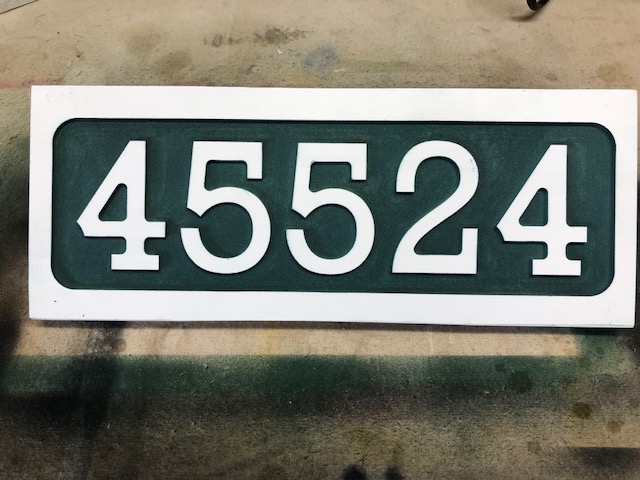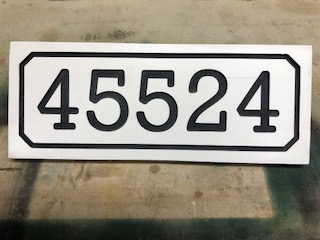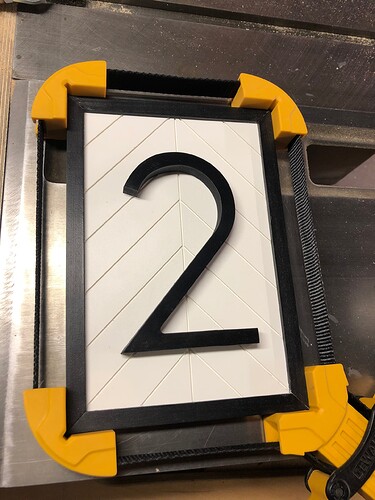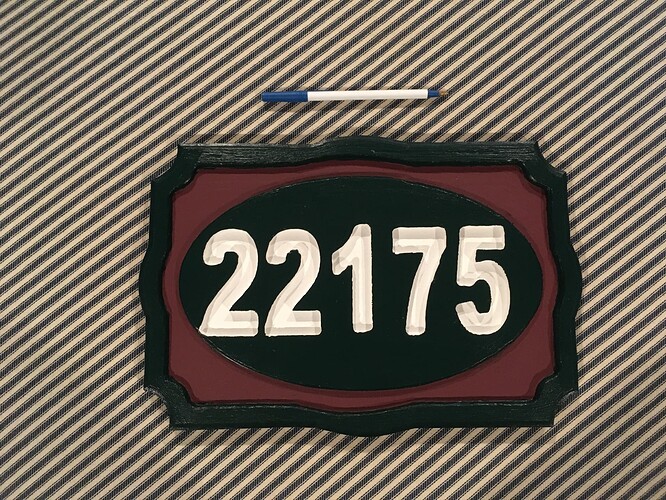I’m hoping to get a few recommendations for what would be the best material to make a set of house numbers out of? I have a lot of aluminum sheet so i was thinking of using that but I suspect it would take a lot of work to get it to take paint well. Would wood be the better option? or even a plastic maybe?
I dont have a picture but i used pvc trim board from my local menards for a friends house numbers. They painted them after and it worked great. Also will stand up to the weather. The boards are flat on one side and a textured woodgrain look on the other side so you can pick your look.
Id also think of how you would attach it. The pvc trim boards you can use screws to attach and then use a pvc plug to hide the screws.
Unless your going to want to repaint or seal again id stay away from a real wood product in my opinion but i hate painting.
The PVC option would be good because it is wateproof and easy to obtain. Wood and aluminum would work but long term the PVC would be best. Not sure if PVC comes in color but house numbers are usually best in black. If you call 911 you want them to be able to find your house. If you paint them without a lot of contrast it can be hard to see house numbers at night. A lot of the metal ones you buy have holes in them so you can use screws/nails. You can just paint the nail/screw head the same color. Use brass screws if they are available for the same water proofing as PVC. Steel screws will deteriorate over time.
I am lucky to have a professional potter in the family. Our house number was hand thrown, glazed and fired in a kiln. Will probably outlast me by centuries.
Out here in Kansas we have the post rock country named aptly for the use of limestone for fence posts where trees are scarce. This was long before the advent of big box stores. It is common to see carved limestone as house numbers. I suspect a Shapeoko could be used to carve limestone.
Just a thought.
Bill
Wow, I bet the finished result is gorgeous. Being pretty new to the world of CNC, I suspect carving limestone may be a little above my skill set right now ![]()
I like the pvc idea, seems like the most straight forward approach and ideal for something going outside. Does pvc machine fairly well? I’ve never cut it before so just trying to get an idea of what to expect.
PVC will machine easily, the trick is to not overheat and melt it. Single flute bits, RPMs low to medium, high feed rates, DOC start small and go deeper as you feel comfortable.
If you are melting, either lower RPMs or increase feed rate.
I use PVC Board by Royal Building Products. Available from Lowes, Home Depot, or Menards. Comes in 3/4 by 5 1/5, 7 1/4, 9 1/4 or 11 1/4 width by 8 foot or 10 foot lengths. Also in 4 by 4 sheets. Cuts well with little cleanup.
Thanks for the tip, just checked with the local lowes and the have a pretty good variety of pvc boards so i definitely think thats the way im going to go.
Do you think i could get away with a 2 flute 1/4’ endmill if i go with a really shallow doc? Thats the only bit i have with a 1’ cutting length which would give me some wiggle room if im going to be cutting 3/4’ stock which is what most of the pvc boards are at my Lowes.
I’ve never cut plastic myself, so I don’t think I can provide much more advise. For a 2 flute, you’ll want to lower the RPMs and increase the feed rate. You might be able to produce chips big enough that you won’t be melting.
I use 1/4 end mill all the time. 24 Plunge Rate and 80 feed rate.
Depth is usually 0.190 and depth per pass is 0.100
Speed is approx 18k
Covering project with clear shelf paper before cutting helps give a cleaner cut but still requires a little cleanup. I use a small jewelers file
I believe some stores also carry some 1/2 or 1/4 PVC Stock
I tried running 3/4 inch through my dewalt planer to get down to 1/2 inch and that was a disaster. PVC doesnt plane well at all ![]()


I use 3M Extreme 2 sided mounting tape for mounting. Couple of strips on the back for mounting to wood or brick and it works great
I think you’d be fine with the two flute. Upcut worked better for me.
Test cuts are a very good best practice.
I just made an address plaque for a friend with 1/2” PVC for the backboard and the number. I used a single flute for the outline outside contours…
If I had 3/4” PVC I would have used it for the frame but I used poplar and painted it.
I made one for my weekend place in the woods (Texas heat and humidity). I found some multi layered HDPE sheet and made a sign with address & street. I cut deep enough to get into the second layer leaving the numbers & letters proud of the background. I used single flute end mills (cut great). I was able to use black with an arctic white background. It has great definition (the house sits back about 50-60 feet from the road). It has been up about a year and looks the same as when I installed it.
That looks great. I was originally thinking just cutting the numbers out but I really like the look of the sign style with the numbers raised. Do you mind if i ask how you went about painting it?
I spray the whole thing with the background color. Let it dry, then take a 2 inch high density foam roller and do the top coat. Carefully apply, not too much paint, and don’t press too hard so the paint doesn’t go down into the cut out part. Use a heat gun to dry, so i don’t have to wait, then apply a second coat.
Cut depth is 0.190. Which seems to work well, deep enough to keep the roller from getting paint into the cut out section
-
Sometimes i use a lint free cloth to dab up some of the extra paint after doing the background color.
-
I sometimes also apply clear vinyl contact paper before i cut the piece. Then spray the background coat, let dry, and remove the contact paper, then paint the top coat. But if there are small details on the design its kind of a pain to peal off all the small pieces of contact paper.
Try everything and see what works for you.
Hope that wasn’t TMI. (Too Much Information)
Here’s one with the opposite design.
Nothing Fancy

I’m still very much a cnc newbie so it’s never too much information ![]() Thanks again to everyone who shared their tips and tricks!
Thanks again to everyone who shared their tips and tricks!
I used 3/4’´ poplar, prepped w/primer plus traditional house paint, with white reflective paint for numbers.
Dennis
That looks awesome, i’ll be thrilled if my project turns out half as good ![]() I ended up buying a pvc trim board today and hope to play around with it tomorrow.
I ended up buying a pvc trim board today and hope to play around with it tomorrow.

